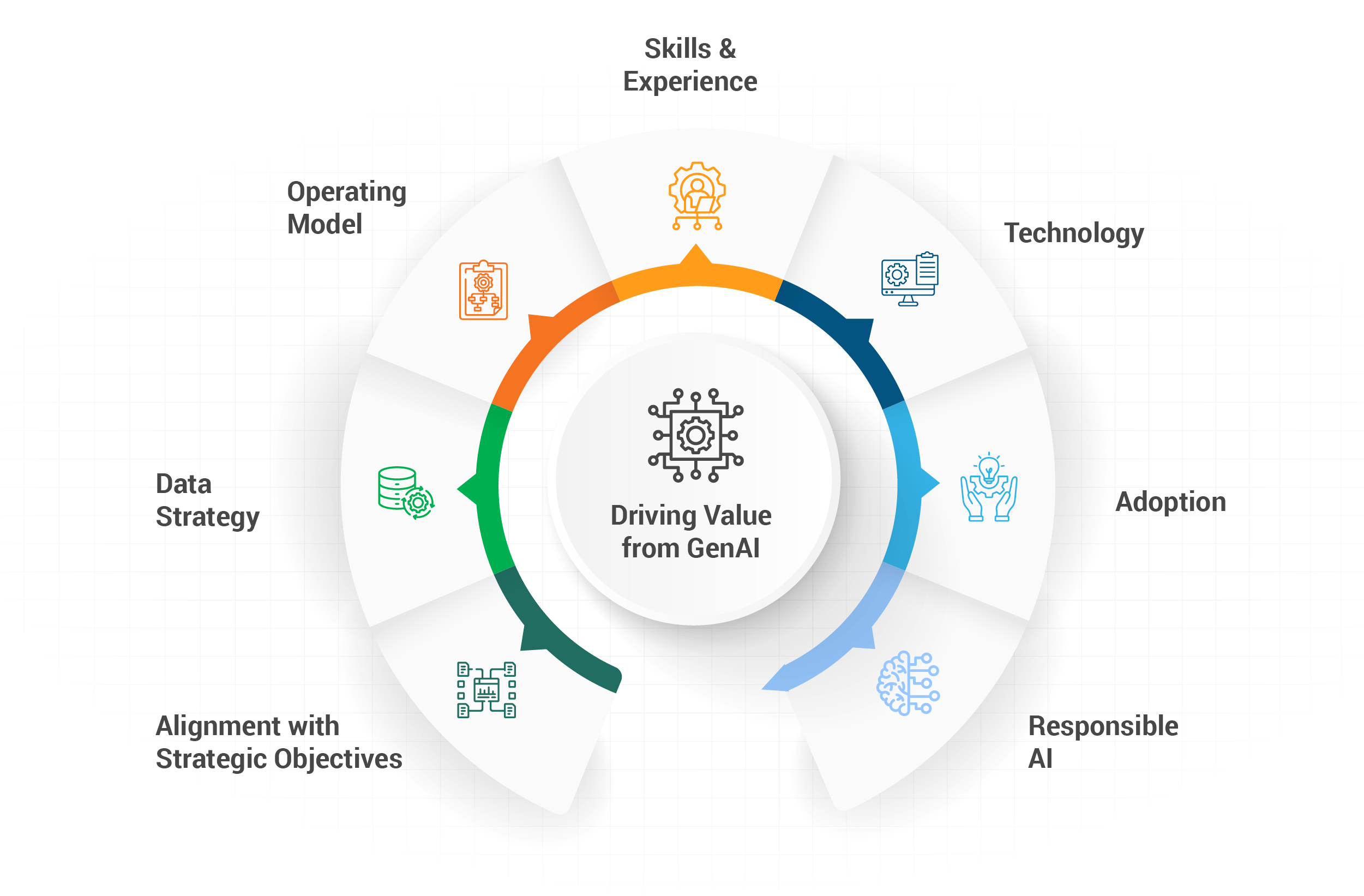Seven pillars of GenAI for enterprise-level value generation

Today, we live in an age of artificial intelligence (AI); more specifically, the age of generative AI (GenAI). In a recent report, 65% of respondents stated that their organisations are regularly using GenAI, with 75% predicting that GenAI will lead to “significant or disruptive change” in the years ahead.1 In life sciences, such disruptive qualities hold much potential for R&D and commercialisation and, ultimately, for patients.
To learn more about the true value of AI and GenAI in pharma, pharmaphorum spoke with Sudip Chakraborty, Principal and Head of AI/GenAI at Axtria, and Amanjeet (Aman) Singh, Head of Strategy & Operations and Strategic Business Unit Leader at Axtria.
Axtria helps life sciences companies harness the potential of data and software to improve patient outcomes by connecting the right therapies to the right patients at the right time. Founded in 2010 by the president and CEO Jaswinder (Jassi) Chadha, who recognised a gap in the life sciences market for data-driven solutions, Axtria seamlessly provides enterprise-grade analytics on integrated software technologies.
During their Ignite 2024 event in June in Princeton, New Jersey, Axtria convened senior industry leaders for an exclusive discussion on the key success factors necessary to generate value through GenAI. Those discussions were distilled into a special report, ‘Going Beyond Pilots: Implementing GenAI for True Value Generation,’ that outlines a seven-dimensional framework that this group discussed and formulated.

1. How does GenAI align with your strategic objectives?
MarketResearch2 says GenAI’s value in the pharma sector will soar to nearly £1.7 billion GBP ($2.2 billion USD) by 2033. It’s clear why getting this framework correct is so important, and it starts with alignment.
“You need two elements to align GenAI initiatives with your company’s strategic objectives,” said Singh. “First, you need your C-suite to be on board. At Ignite, one thing emerged: everyone acknowledged that executives have no dearth of interest in the potential of GenAI. We even joked that it's more likely to be funded if we attach GenAI to almost any initiative. As a result, many pilots are underway across the commercial, clinical, and R&D areas of pharma.”
However, as Singh noted, the second element takes more effort. “The leaders told us that GenAI’s value has to be proven before it can be considered properly aligned with objectives,” he added. “And to prove its value, you must measure it in three key areas: the meaningful improvements to your processes, the reduction in operational costs that it brings, and the amount of revenue growth it enables.”
Singh also noted that companies may run into challenges during measurement efforts. “There is a lack of effective toll gates and continuous evaluation mechanisms,” he said. “Solving for that means implementing those checks during new initiatives and consistently engaging C-level leadership with these metrics.” But interestingly, Singh pointed out that it also takes a fair amount of creativity. “Storytelling is key,” he revealed. “Emphasizing the ‘why’ over the raw metrics will drive home the process and highlight successes.”
2. What should your data strategy look like to unlock rapid value creation through GenAI?
Once objectives are identified and lined up, the next step involves having a robust data strategy. Although every industry focuses on their data, this pillar is unique to the pharma industry, thanks to the type of information they see.
“At Ignite, leaders talked about how the vast majority of data pharma companies have access to is unstructured data,” said Chakraborty. “They’re taking in images and video, as well as audio, like dictated notes. How do you deal with that?”
Chakraborty summarized this challenge in four words: volume, velocity, variety, and veracity. “We talk about fast processing of data, but we also want to use GenAI to reduce data latency—the time from when an event happens to when a doctor can use the insight from it to make better decisions about a patient. The latency, for example, in oncology can sometimes be several months.”
The cost of integrating and managing all this data can become significantly higher. That’s also where GenAI shines, according to Chakraborty. “Given the generative capabilities of GenAI, there's a need to explore ways of generating content automatically, faster, and at lower cost,” he said.
But will the users of this data trust it all, considering the increased speed and sources? Here, too, Chakraborty turns to GenAI. “Veracity is a thread that is linked with all parts of the GenAI app development and deployment and usage phases: you want to make sure you start with trusted data,” he highlighted. “Make sure that at every stage, you're only taking data that is relevant and trustworthy. You don't want any toxicity or bias or IP infringement.”
3. To accelerate GenAI value, what needs to change might be your operating model and how work gets done?
Once objectives are aligned and a data strategy is laid out, Singh says the next step is accelerating GenAI value. That often requires a change in how a gets work done…or your operating model. “We’ve seen that GenAI can deliver 30% to 50% gains in efficiency and effectiveness when you effectively reshape processes and functions,” Singh revealed.
He explained what some of those changes may look like. “Some organizations have gone ahead and created what they call AI councils, AI operating committees, and so on, where the governance of all the AI programmes is being run internally,” he said. “We need to strengthen the whole governance mechanism and get it to a level of uniformity across the industry. The whole funding process also needs to be revisited.”
Singh shared another operational change identified by the leaders in the exclusive session. “We need a partnership ecosystem. We must ensure that new technologies, methodologies, and tools can operate with what’s already in place,” explained Singh. “We can't create a completely siloed parallel track of these technologies and tools and keep them independent of what already exists in the organisation.”
Singh says managing expectations is vital. “We need to manage hype,” he continued. “Look at what realistically can be achieved in the short-term versus the long-term when deciding whether a particular GenAI initiative should be continued, pivoted, or completely eliminated.”
4. Do you have the skills and experience to get the most out of GenAI?
Singh points out that despite GenAI doing much of the heavy lifting, we need to remember the need for a human in the loop. However, Axtria’s executive session identified a unanimous concern: employees’ skills do not yet meet the standards required to leverage the full potential of GenAI technologies.
“This isn’t about fear of new tech but recognizing the need for a strategic upskilling initiative,” revealed Singh. One leader told the session that upskilling should be about fostering a culture of continuous learning and innovation: not just preparing for the future but actively shaping it.
Singh says foundational knowledge is required, such as familiarity with a GPT model, but it goes beyond that. “We aim to prioritize learning areas that promise genuine competitive differentiation,” he adds. “This ensures we’re not just participants but leaders in harnessing GenAI capabilities.”
Framing the learning process through the lens of business context will help employees understand the ‘why.’ Singh believes this removes fears of replacement while driving their overall adoption of GenAI. “Encourage experimentation,” Singh suggests. “Hands-on learning and integrating GenAI advancements into our operations will enhance productivity and drive towards the organisation’s ambitious goals.”
5. What is your approach to GenAI technology investments?
“While keeping employees current on skills, organisations must do the same with technology investments,” shared Chakraborty. “We asked our executive participants, ‘Where do you invest? Why are you investing? How should you invest? How do you keep up with GenAI?’”
“Participants shared that you need to ensure you have a modern data infrastructure that can handle both large volumes and velocities of unstructured data in conjunction with structured data,” said Chakraborty. “Knowing how to use and interact with large language models as they show various types of behavior is important,” he said.
GenAI’s recurring cost is a factor as well. “Many of the models in use, especially the ones pharma companies are using, tend to be pay-per-use,” Chakraborty revealed. “As usage explodes, there’s a potential for significant cost growth.”
There’s a final yet critical investment hurdle to clear. Chakraborty calls it the “consumption layer,” where the output from GenAI comes into daily workflows. “How do you get your employees to use these LLMs to provide better business outcomes?” he continued. “Our group said that integrating LLMs like GPT in business contexts can be costly. So, we need to ensure this does not require significant technical training to ensure good adoption.”
Chakraborty suggests shifting from capital to operational expenditures to help solve these investment questions. He also says many organisations are using “innovation budgets” that often have a longer runway for showing returns on investment.
6. How are you driving GenAI adoption?
You can spend significant effort crafting GenAI strategy, changing processes, and skills, but none of that matters if your employees aren’t using the technology. “We’ve created an adoption framework to propel organisations toward success,” said Singh. “To do this, we suggest creating a sense of urgency to stay competitive. Inspire and rally your teams by clarifying the impact of these initiatives, and communicate that vision multiple times across various levels,” Singh added.
“Next, don’t be afraid to get your hands dirty. Build a small coalition of leaders who will provide the flexibility to experiment and learn with GenAI and do trials,” explained Singh. “Trying new things is not just allowed but celebrated.”
Singh believes organisations must celebrate short-term wins and early successes of GenAI projects. “They not only validate your efforts but help communicate the value and build momentum, creating a positive feedback loop,” he said.
Singh is adamant that sustaining this momentum is one of the most challenging aspects of employee GenAI adoption. “Establish a continuous mechanism to identify the next set of impactful use cases,” he said. “This assembly-line approach ensures our momentum never wanes.”
7. How can responsible AI practices protect you?
The final part of Axtria’s framework for GenAI value creation deals with using GenAI responsibly. As GenAI’s abilities advance, more avenues of concern may appear. Chakraborty says the right practices can alleviate those worries.
“Responsible AI means security, respecting privacy, transparency, predictability, being ethical and unbiased, intellectual property protection, and equity and fairness,” said Chakraborty. “Many of our clients, many of the top pharma companies, actually, have AI governance councils, which are responsible for making sure that their organisations are using responsible AI practices.”
Chakraborty says these councils take a holistic approach by engaging all stakeholders. “This includes patient groups, customer groups, and others directly impacted by these AI systems,” he said. “It’s also about the responsible use of resources,” Chakraborty added. “Governance is crucial to ensure patient and customer data are handled with care and to foster trust in the system.”
“However, our executives participants went beyond the industry meaning of responsible AI,” he continued. “In a further conversation, one of our clients mentioned, ‘How do we make sure that we are neither over-investing nor under-investing?’” Chakraborty says establishing a coherent framework that involves all stakeholders helps solve that and ensures responsible AI principles are integrated effectively.
Axtria is hosting a 30-minute webinar on Tuesday, October 29, 2024, at 1:00 PM ET if you’d like to learn more or ask questions of Singh and Chakraborty:
References
About the interviewees
 Amanjeet Singh is a seasoned leader in AI, analytics, and cloud software, currently heading strategy and operations at Axtria Inc. Singh has built, scaled, and exited three successful ventures, is the original inventor of a US patent for collection cycle optimisation through advanced analytics, and brings 25 years of experience advising Fortune 500 clients in financial services, life sciences, and medtech on risk management, commercial strategies, and advanced analytics.
Amanjeet Singh is a seasoned leader in AI, analytics, and cloud software, currently heading strategy and operations at Axtria Inc. Singh has built, scaled, and exited three successful ventures, is the original inventor of a US patent for collection cycle optimisation through advanced analytics, and brings 25 years of experience advising Fortune 500 clients in financial services, life sciences, and medtech on risk management, commercial strategies, and advanced analytics.
 Sudip Chakraborty is the Head of AI/GenAI at Axtria, where he advises pharma clients on leveraging AI and GenAI to drive business outcomes, leading to measurable improvements in productivity and efficiency. With over 25 years of experience, his expertise spans developing AI/GenAI strategies and roadmaps, building high-performing teams, and establishing AI/GenAI and MLOps/LLMOps capabilities. Chakraborty's leadership has been instrumental in driving the adoption and monetisation of AI technologies across various business units. Earlier in his career, he co-founded an AI consulting firm, growing it to 250 professionals before a successful exit. Chakraborty also holds two patents in algorithms and data observability and is recognised as a thought leader in the industry. He is passionate about mentoring the next generation of AI leaders and fostering a culture of innovation.
Sudip Chakraborty is the Head of AI/GenAI at Axtria, where he advises pharma clients on leveraging AI and GenAI to drive business outcomes, leading to measurable improvements in productivity and efficiency. With over 25 years of experience, his expertise spans developing AI/GenAI strategies and roadmaps, building high-performing teams, and establishing AI/GenAI and MLOps/LLMOps capabilities. Chakraborty's leadership has been instrumental in driving the adoption and monetisation of AI technologies across various business units. Earlier in his career, he co-founded an AI consulting firm, growing it to 250 professionals before a successful exit. Chakraborty also holds two patents in algorithms and data observability and is recognised as a thought leader in the industry. He is passionate about mentoring the next generation of AI leaders and fostering a culture of innovation.
About Axtria

Axtria helps life sciences companies harness the potential of data science and software to improve patient outcomes by connecting the right therapies to the right patients at the right time. The company is a leading global provider of award-winning cloud software and data analytics to the life sciences industry. It is proud to deliver proven solutions that help pharmaceutical, medical device, and diagnostics companies complete their journey from data to insights to action, enabling them to earn superior returns on their investments. As a participant in the United Nations Global Compact, Axtria is committed to aligning strategies and operations with universal principles on human rights, labour, environment, and anti-corruption, and taking actions that advance societal goals. For more information, please visit www.axtria.com.












